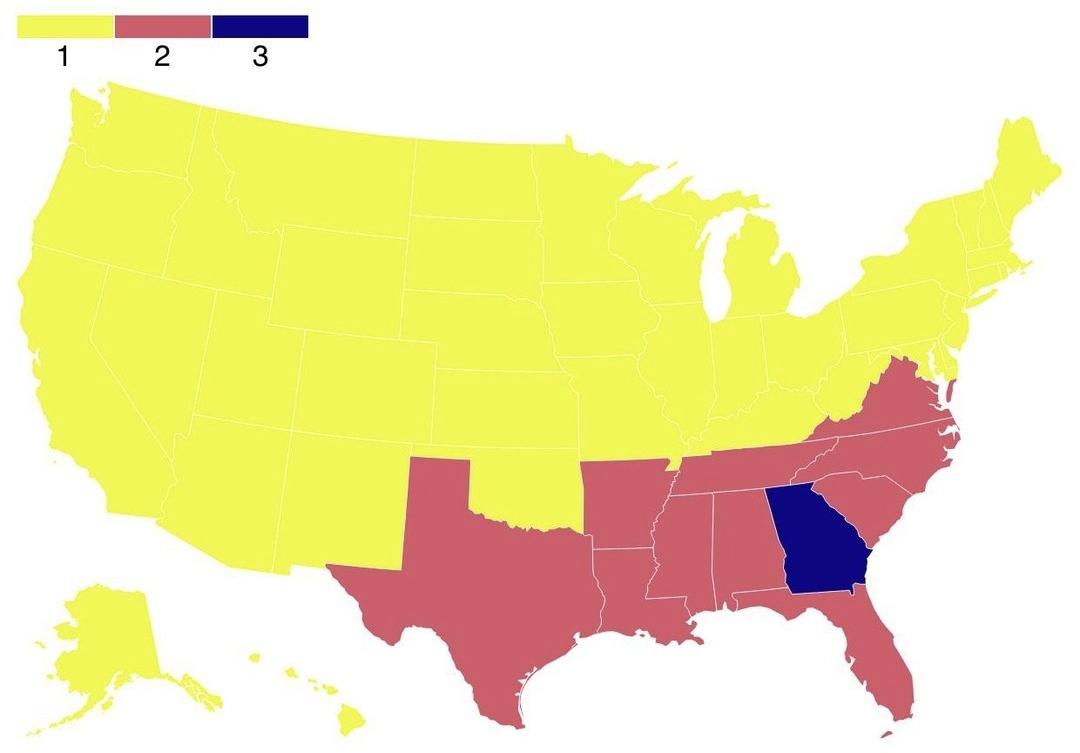Map of States by Admission into the Union


Alex Cartwright
Senior Cartographer & GIS Specialist
Alex Cartwright is a renowned cartographer and geographic information systems specialist with over 15 years of experience in spatial analysis and data...
Geographic Analysis
What This Map Shows
The map titled "Map of States by Admission into the Union" provides a visual representation of the number of times each U.S. state has been admitted into the Union. This fascinating map categorizes states based on their admission history, illustrating the complexities of statehood in the United States.
Examining this map not only highlights the chronological order of admissions but also delves into the political and social implications tied to these events. For instance, Georgia, which was first admitted on January 2, 1788, as the fourth state, has a unique and tumultuous admission history that reflects broader national trends.
Deep Dive into State Admissions
The process of state admission into the Union has been a complex journey marked by historical, political, and social nuances. From the establishment of the original thirteen colonies to the incorporation of the last states in the 20th century, each state's path to statehood tells a story of struggle, negotiation, and transformation.
Interestingly, the admission of states is not a straightforward process. Initial states were formed from colonies and territories, but as the nation expanded westward, the dynamics shifted. The Northwest Ordinance of 1787 set a precedent for how new states would enter the Union, establishing a process that included the formation of a territorial government, a population threshold, and the drafting of a state constitution.
However, what’s particularly compelling is the fact that some states, like Georgia, experienced multiple admissions. Georgia was first admitted in 1788 but faced significant political strife during the Reconstruction era. Following the Civil War, Georgia was initially readmitted in July 1868 but was expelled the following December due to unrest and actions against Black legislators. This tumultuous period reflects the deep-seated racial and political tensions that shaped the post-war United States. Finally, Georgia was readmitted for the second time on July 15, 1870, after a new legislature ratified the Fifteenth Amendment, allowing Black men the right to vote and signifying a crucial step towards equality.
The history of state admissions is also a narrative of compromise. States were often admitted in pairs to maintain the balance between free and slave states, especially during the contentious antebellum period. This balancing act was evident in the admission of states like Maine and Missouri in 1820, which were part of the Missouri Compromise.
Moreover, unique factors influenced the admission of certain states. For example, the California Gold Rush in the mid-1800s accelerated California's admission as a free state in 1850, while the vast and largely uninhabited lands of the western territories took longer to achieve statehood.
Regional Analysis
Analyzing the map regionally reveals intriguing patterns in state admissions. The Northeast, which includes the original colonies, shows a relatively rapid admission process, with many states entering the Union in the late 18th century. In contrast, the Western states, such as Arizona and New Mexico, faced significant delays due to various factors, including indigenous land disputes and governance challenges.
In the South, states like South Carolina and Texas also have notable histories of readmission and expulsion. Texas, for example, was an independent republic before joining the Union in 1845 and later seceding during the Civil War, only to be readmitted in 1870.
The Midwest presents a unique case as well, with states like Ohio and Indiana admitted relatively early, while others like North Dakota and South Dakota were among the last to join in 1889. The reasons for this variance often relate to demographic growth, economic viability, and political negotiations at the federal level.
Significance and Impact
Understanding the admission history of states is crucial for grasping the evolution of the United States as a political entity. Each state's journey into the Union was not just a matter of geographical expansion but also a reflection of the social, economic, and political realities of the time.
This topic is particularly relevant today as we observe ongoing discussions about statehood for territories like Washington D.C. and Puerto Rico. The historical context of state admission can inform current debates about representation, governance, and civil rights.
As we look to the future, the implications of state admissions extend beyond mere geography; they touch upon issues of identity, equality, and the continuing evolution of democratic governance in the United States. Have you ever wondered how these historical patterns might influence future admissions? The dynamics of political representation and statehood remain as relevant today as they were in the past, reminding us that the story of the United States is still being written.
Visualization Details
- Published
- October 16, 2025
- Views
- 12
Comments
Loading comments...